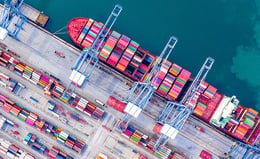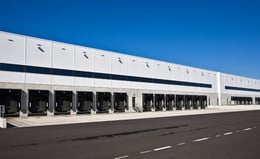How Much Longer Can Supply Chain Teams Work Remotely?
Martin Pahulje - May 20, 2021
Over the past year, nearly every industry has been impacted by the COVID-19 pandemic, forcing team members to adjust to working remotely. The transition to remote work was considered a temporary measure in efforts to stop the spread of the virus, but it does not seem as though it's going anywhere. As a result, many companies are fully embracing the remote style of work. While this works for some organizations, it may not be sustainable for all. In the supply chain industry especially, adjusting to remote work has been a significant change. As we adjust to our new normal, supply chain companies wonder how much longer they can continue to work remotely. Is this sustainable for businesses? Fortunately, technological advancements have made this possible. We will discuss the implications of remote work for supply chain teams and the tools they can implement to continue to work remotely.
Cloud Software
The supply chain industry is one of the most complex to transition into remote work. Because so many processes are located in-office, it can be challenging to manage them without being present. Databases and hardware that must be accessed manually are no longer feasible if team members work from home, so companies must find an alternative. An excellent remote-enabled software is cloud software. One of the most significant benefits of the cloud is its ability to connect team members in remote workplaces. As data is not stored in a tangible database, it can be accessed from any location. Your team members will have the ability to access data and systems while working remotely simultaneously, and they will have more logistics flexibility than before.
Some organizations are hesitant to implement cloud software due to concerns with its security, but this concern is minor. Cloud software includes significant measures to ensure that data is always protected. With the ability to authorize only certain users, you can ensure that the only ![]() people with access to private information are the ones intended to access it. Furthermore, organizations can choose to utilize cloud applications that do not share confidential data. Cloud has the ability to label software to manage label templates, thus allowing users to store label templates in one place and only give access to third-party users as needed. Your label data will be secure, and you will reduce time spent emailing templates back and forth, in addition to ensuring improved accuracy.
people with access to private information are the ones intended to access it. Furthermore, organizations can choose to utilize cloud applications that do not share confidential data. Cloud has the ability to label software to manage label templates, thus allowing users to store label templates in one place and only give access to third-party users as needed. Your label data will be secure, and you will reduce time spent emailing templates back and forth, in addition to ensuring improved accuracy.
Implementing cloud software is a quick and straightforward process, especially if you work with the right provider. Many on-premise solutions already have cloud-based versions, making the transition period nearly seamless. For organizations looking to optimize and continue their remote work, cloud solutions are key.
Multi-Dimensional Monitoring
Another instrumental tool in enabling remote work is multi-dimensional monitoring. As team members will be working from home, they will not have the same physical access to systems as they once had – or at least not full time. But, even though team members may not be on-premise, they still need this access to perform their work. Multi-dimensional monitoring allows team members to track their operations from start to finish, whether they are working in-office or remote. With real-time tracking, users will have full visibility over the supply chain network at all times. This includes the status of shipments, manufacturing, regulatory compliance, and even operational risks. Not only does this advanced level of monitoring allow for you to manage and observe your supply chain while remote, but it will optimize your supply chain as well. One of the most significant advantages of multi-dimensional monitoring is its ability to monitor cargo with IoT-enabled monitoring and tracking. With the use of sensors, you will be able to collect data on all materials and products in the supply chain, following them as they move through the network. These sensors will also alert you of any delays or disruptions so that issues can be resolved instantly. With this technology, you can plan ahead of disruptions and spot risks early, ensuring that your supply chain is more resilient than ever. Monitoring will provide you with better insights and visibility than when on-premises. Plus, this information can be accessed at any time and from any location - making remote work entirely feasible.
AI & Machine Learning
In addition to cloud software and multi-dimensional monitoring, automation is necessary for every supply chain, especially now. By automating supply chain systems and processes, the need for manual labor can be significantly minimized. For team members working remotely, this is a great advantage. Rather than manually performing autonomous tasks, technologies such as AI and machine learning can do that for you. This leaves more time and energy for team members to work on more important tasks that do not need to be conducted on-premise. One of the greatest uses for machine learning (ML) is taking in historical data to create forecasts. This can help users to predict future demand, anticipate fluctuating freight prices, and more. With these algorithms provided by ML, team members can get ahead of planning and make better operational decisions for the future. In the age of uncertainty, gaining a better resiliency and elasticity for plans is a must. ML is also excellent in optimizing digital twins, finding hidden connections that make it easier to connect and share data throughout the supply chain network.
In addition to ML, AI is equally helpful to optimize the supply chain for remote work. It is evident that machinery and technology are significant components of any supply chain. By implementing  AI into your operations, you can automate these systems further, reducing the need for on-premise users. With AI, you can monitor machine usage on an ongoing basis. This allows users to do preemptive maintenance on systems, thus preventing wasted time and money spent on unexpected breakdowns. Not only will this reduce downtime, but it will enable your team members to work remotely until they must come into the workplace. Managing your on-premise technology is exceptionally vital to the efficiency of a supply chain, and AI will allow you to do so remotely. Not only this, but it will also significantly increase resiliency, ensuring that you can avoid and bounce back from disruptions faster than ever before.
AI into your operations, you can automate these systems further, reducing the need for on-premise users. With AI, you can monitor machine usage on an ongoing basis. This allows users to do preemptive maintenance on systems, thus preventing wasted time and money spent on unexpected breakdowns. Not only will this reduce downtime, but it will enable your team members to work remotely until they must come into the workplace. Managing your on-premise technology is exceptionally vital to the efficiency of a supply chain, and AI will allow you to do so remotely. Not only this, but it will also significantly increase resiliency, ensuring that you can avoid and bounce back from disruptions faster than ever before.
Remote work is a new concept to many companies, and it can be challenging to adjust to. While it may seem increasingly difficult for supply chain organizations to maneuver this work style, it is achievable and can be beneficial. With the use of smart technology such as cloud software, multi-dimensional monitoring, AI, and ML, remote work is a feasible and sustainable practice. These solutions are available to implement into the systems likely present in your supply chain currently, further optimizing the work you already do. Remote work is here to stay, and with the technology available today, it is an excellent solution for creating a safe, productive, and thriving workplace. While there is no clear answer to how long professionals will continue to work remotely, but it is clear that it's here to stay to some extent. Utilizing supply chain technology will optimize your supply chain – both remote and on-premise.
Click below to download our guide on multi-dimensional monitoring.
LATEST POSTS
- Understand Why Production Planning Needs Specialized Solutions
- Understand Circular Economy in The Manufacturing Industry
- How Can Industry 4.0 IT Integration Be Achieved Smoothly?
- The Significance of Order Sequencing in Discrete Manufacturing
- How to improve your Supply Chain Management: The Power of Control Towers



